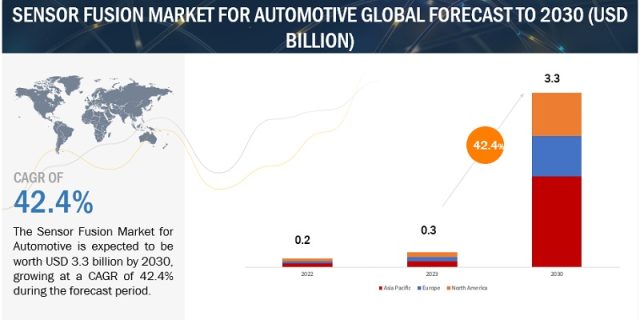
The global sensor fusion market for automotive is projected to grow from USD 0.3 billion in 2023 to USD 3.3 billion by 2030, registering a CAGR of 42.4%. With technological advancements, increasing safety demand, and supportive government regulations, vehicles with sensor fusion have gained significant traction as a viable and sustainable transportation option. Government and regulatory bodies globally have intensified their focus on enhancing road safety, prompting the enforcement of stringent safety standards and vehicle mandates. As a result, the sensor fusion market for automotive is experiencing robust growth, given its integral role in making vehicles safer and aligning with worldwide safety regulations.
Increasing advancements in ADAS technology
The continuous advancement of ADAS technology is driving the demand for comprehensive sensor fusion solutions within the automotive industry. While ADAS already encompasses a wide range of safety and automation features, such as adaptive cruise control and lane-keeping assistance, the ongoing evolution of this technology has given rise to new and exciting applications that leverage advanced sensors and AI capabilities. One of the most notable advancements is in automatic parking systems. These systems go beyond simple parking assistance by enabling vehicles to navigate parking lots and tight spaces autonomously. They utilize a combination of sensors, including cameras and ultrasonic sensors, to detect obstacles, assess parking spaces, and execute precise parking maneuvers. Another significant development is in active lane keep assist. This technology alerts the driver when they’re drifting out of their lane and actively steers the vehicle to keep it within the lane. Automated driving systems are becoming more sophisticated, enabling traffic jam assist and highway pilot features. These systems use a combination of sensors, including cameras and LiDAR, to provide semi-autonomous driving capabilities. They can handle tasks like maintaining a safe following distance, navigating stop-and-go traffic, and changing lanes under certain conditions. Pedestrian avoidance systems use a mix of sensors, including cameras and radar, to detect pedestrians near the vehicle and take action to avoid collisions. This includes both visual and audible alerts to the driver, as well as automated braking if necessary. As consumers and regulators demand higher safety standards and vehicles transition toward higher levels of automation and autonomy, the need for sensor fusion has increased. Ensuring the accuracy and redundancy of sensor data is essential in realizing the safety and reliability expected from ADAS and autonomous driving systems.
Request Free Sample Report @ https://www.marketsandmarkets.com/requestsampleNew.asp?id=260287840
Rising demand for safer and sustainable transportation solutions
The use of sensor fusion as an integral component of ADAS has enhanced vehicle safety and led to more fuel-efficient and eco-friendly vehicles, making a substantial contribution to sustainability. ADAS relies on LiDAR, radar, cameras, and ultrasonic sensors to gather real-time data about the vehicle’s surroundings, enabling it to make informed decisions to improve safety and driving efficiency. This data-driven approach has significant implications for sustainability. Sensor fusion aids in optimizing driving behavior by providing critical information to ADAS systems, such as adaptive cruise control and lane-keeping assistance. These features can reduce aggressive driving patterns, leading to smoother acceleration and deceleration, reducing fuel consumption, and lower emissions. The enhanced situational awareness offered by sensor fusion allows ADAS systems to make precise decisions on route planning and traffic management, minimizing fuel waste and reducing the carbon footprint. For example, vehicles can take more efficient routes, avoiding traffic congestion and idling, leading to fuel savings and emission reduction. Sensor fusion contributes to developing autonomous and electric vehicles, key elements in sustainability efforts. Sensor fusion is fundamental to the safe operation of autonomous vehicles by providing a comprehensive view of the vehicle’s surroundings, reducing the potential for accidents.
Moreover, electric vehicles benefit from sensor fusion by optimizing energy usage and improving regenerative braking systems. As global efforts to reduce carbon emissions and combat climate change intensify, the automotive industry is under pressure to develop more sustainable transportation solutions. The role of sensor fusion in making vehicles safer and more fuel-efficient aligns with these objectives, offering an opportunity for the sensor fusion market for automotive. As a result, continued growth is anticipated in adopting sensor fusion technology, both in developing existing vehicles and in shaping the future of sustainable mobility.
Asia Pacific to be the largest market by value during the forecast period
China, Japan, and South Korea account for the largest share of the sensor fusion market for automotive in the Asia Pacific region. The market growth in this region can be attributed to the high vehicle production and increased use of advanced electronics in Japan, South Korea, and China. These countries’ governments have recognized the automotive industry’s growth potential and have consequently taken different initiatives to encourage major OEMs to enter their domestic markets.
Key Market Players
The Sensor Fusion Market for Automotive is dominated by Mobileye Global Inc. (Israel), NVIDIA Corporation (US), Qualcomm Incorporated (US), Tesla Inc. (US), and Huawei Technologies, Co., Ltd. (China), among others.
Inquire Before Buying @ https://www.marketsandmarkets.com/Enquiry_Before_BuyingNew.asp?id=260287840

